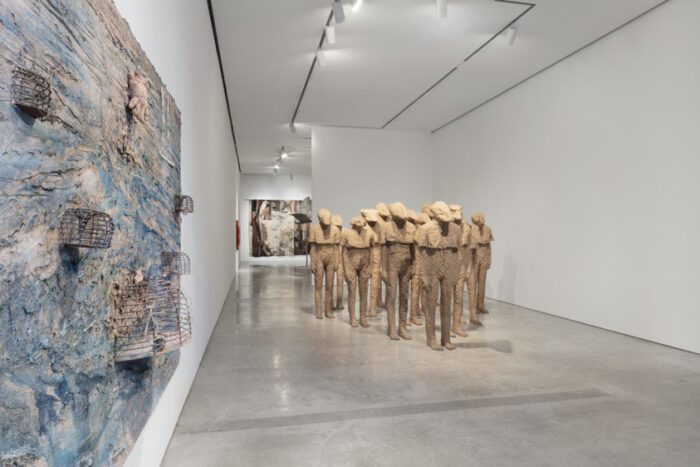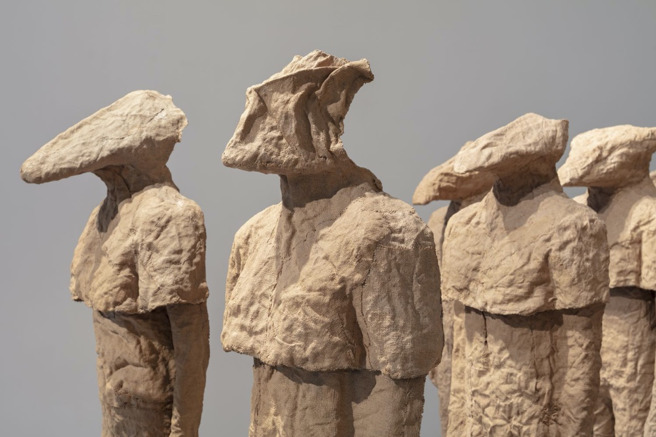
Magdalena Abakanowicz and Anselm Kiefer
September 29 – November 28, 2020
All images courtesy of Marlborough Gallery and the Artists
Among the excellent Chelsea shows currently on view, the dual show of Magdalena Abakanowicz and Anselm Kiefer at Marlborough gallery stands outs with its symbolism and magnetic presence. If our uncertain times need a strong moral reference point and artistic parallels to how people lived through difficult, uncertain, tragic times the two masters provide this. Abakanowicz and Kiefer’s works communicate collective suffering and survival through the individual stories of their objects as well as their authors. They both speak in metaphors of how we can see beyond the ongoing crises and relate through shared humanity; how art is created, used, and processed in response to global paradigm shifts.
Along with her famed weavings, Magdalena Abakanowicz (1930-2017) is presented with two groups of androgynous, anonymous figures she started creating in the 1980s, calling them crowds. By working on crowds with burlap and resin and later casting some in bronze, she continuously addressed the idea of individuality within the constraints of a collectivist society, Orwellian dilemmas within authoritarian constructs. Abakanowicz grew up in Poland and suffered traumatizing violent changes affecting her homeland in the twentieth century, as Poland continued to be at the demarcation lines of World War II and the Cold War. These historic repercussions show up in Abakanowicz’s body of work as she used deeply emotional and subtly expressed undercurrents to tell her story. By using large groups of burlap bodies, the artist questioned our own place in hierarchies and societies we create. Although superficially Crowd III on view at the gallery could remind emperor Qin Shi Huang’s Terracotta Army, Abakanowicz’s approach to the problem of the collective is more nuanced. She creates multitudes of figures, but each one of them has distinguishing marks, stressing individuum, and her/his existence within the collective. Subtle differentiation of creases, proportions, forms distinguish one faceless or headless figure from the next, thus allowing viewers to relate, to embody, to imagine oneself in that particular body. This would not be possible if every single figure was industrially, sterilely the same. By allowing variations Abakanowicz creates an identifiable reality rather than a formalist representation of it.



Another body of work represented in this eloquent show is centered around the artist’s well-known soft sculptures weaved from unraveled and dyed ships’ ropes as well as horsehair and cotton. Abakans were the first sculptures that introduced Abakanowicz to the global art scene. Initially, in order to be shown in the West, they had to be disguised as ‘craft’ products rather than abstract sculptures. Organic, ambiguous, rich forms of these works from different periods of the artist’s life traces her engagement with the medium. They also show how Abakanowicz moved from something more complex to simpler, more charged, more mysterious, more significant. Anselm Kiefer is presented by one enigmatic work. Ich halte alle Indien in meine Hand (I am holding all of India in my Hand), distills his preoccupation with identity, belonging, surface, depth, and birdcages. In a way, these birdcages mirror Abakanowitcz’s faceless crowds as both trap spiritual inside the material, individual within a construct. Kiefer shows a single human hand on his burned blue soil as a human attempt to hold onto one’s roots, yet failing to do so. His symbolism here aligns with Abakanowitcz’s strive to understand one’s place in history, assume one’s responsibility in a society of multitude and anonymity. This is a question for our time too.


Video walk-through of Magdalena Abakanowicz and Anselm Kiefer at Marlborough Gallery, NYC

